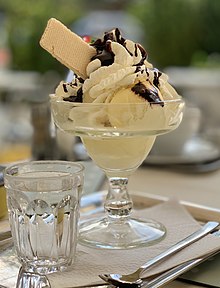
Back Roomys Afrikaans አይስ ክሬም Amharic Īsrēam ANG مثلجات Arabic لاباني ARY ايس كريم ARZ আইচ ক্ৰীম Assamese Xeláu AST Ka takaiak ATJ Dondurma Azerbaijani
 | |
| Type | Frozen dessert |
|---|---|
| Main ingredients | Milk, cream, sweetener, flavoring |
| Variations | Gelato, frozen custard |
Ice cream is a frozen dessert typically made from milk or cream that has been flavoured with a sweetener, either sugar or an alternative, and a spice, such as cocoa or vanilla, or with fruit, such as strawberries or peaches. Food colouring is sometimes added in addition to stabilizers. The mixture is cooled below the freezing point of water and stirred to incorporate air spaces and prevent detectable ice crystals from forming. It can also be made by whisking a flavoured cream base and liquid nitrogen together. The result is a smooth, semi-solid foam that is solid at very low temperatures (below 2 °C or 35 °F). It becomes more malleable as its temperature increases.
Ice cream may be served in dishes, eaten with a spoon, or licked from edible wafer ice cream cones held by the hands as finger food. Ice cream may be served with other desserts—such as cake or pie—or used as an ingredient in cold dishes—like ice cream floats, sundaes, milkshakes, and ice cream cakes—or in baked items such as Baked Alaska.
Italian ice cream is gelato. Frozen custard is a type of rich ice cream. Soft serve is softer and is often served at amusement parks and fast-food restaurants in the United States. Ice creams made from cow's milk alternatives, such as goat's or sheep's milk, or milk substitutes (e.g., soy, cashew, coconut, almond milk, or tofu), are available for those who are lactose intolerant, allergic to dairy protein, or vegan. Banana "nice cream"[a] is a 100% fruit-based vegan alternative. Frozen yoghurt, or "froyo", is similar to ice cream but uses yoghurt and can be lower in fat. Fruity sorbets or sherbets are not ice creams but are often available in ice cream shops.
The meaning of the name ice cream varies from one country to another. In some countries, such as the United States, ice cream applies only to a specific variety, and most governments regulate the commercial use of the various terms according to the relative quantities of the main ingredients, notably the amount of cream.[1] Products that do not meet the criteria to be called ice cream are sometimes labelled "frozen dairy dessert" instead.[2] In other countries, such as Italy and Argentina, one word is used for all variants.
Cite error: There are <ref group=lower-alpha> tags or {{efn}} templates on this page, but the references will not show without a {{reflist|group=lower-alpha}} template or {{notelist}} template (see the help page).
- ^ "Ice Cream Labeling: What Does it all Mean?". International Foodservice Distributors Association. Archived from the original on 14 May 2008. Retrieved 9 August 2008.
- ^ "Ice Cream's Identity Crisis". The New York Times. 17 April 2013. Archived from the original on 2 January 2017. Retrieved 1 January 2017.